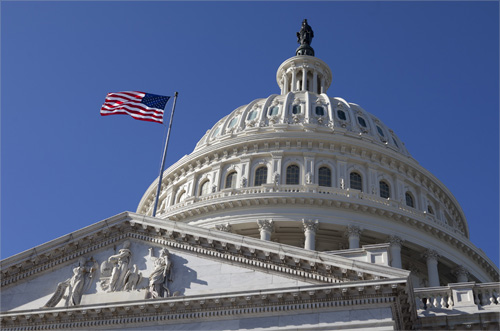Last Friday, President Trump signed into law two appropriations bills that extend government funding while also dealing with several of the tax extender provisions and repealing some Obamacare taxes.
Both H.R. 1158, Consolidated Appropriations Act, and H.R. 1865, Further Consolidated Appropriations Act, averted a government shutdown that would have commenced on Dec. 21, 2019 without this sweeping $1.4 trillion spending package being passed into law. Most of the new Act outlines how the government will appropriate the federal budget funding across numerous departments and programs, including the Treasury Department.
Scope of the retroactive and prospective tax extenders
The most broadly applicable tax law changes in the new Act are in connection to the tax extenders provisions. Historically, individual-level and business entity-level tax extenders have normally been extended for only one-year or two-year durations dating back over 30 years. However, over time some of the temporary tax incentives have been made permanent (e.g., the RD Tax Credit was made permanent under the Protecting Americans from Tax Hikes Act of 2015 after being a temporary provision within the Tax Code since its inception via the Economic Recovery Tax Act of 1981.) The new Act reinstates many of the previously expired tax incentives that were not addressed under the Bipartisan Budget Act of 2018 or the Tax Cuts and Jobs Act of 2017, for a three-year duration term, making them retroactively effective for 2018 and 2019 while prospectively extending them through the end of 2020.
Individual tax extenders
Just a few of the more popular individual tax extenders include the reduction in the adjusted gross income floor for medical and dental expense deductions from 10 percent to 7.5 percent; the above-the-line deduction for tuition and fees; the treatment of mortgage insurance premiums as deductible qualified resident interest, and the exclusion of qualified residence indebtedness from gross income. In addition, this new Act will encompass retirement plan funding, distribution and administrative changes to individual retirement accounts and 401(k) plans.
Business tax extenders
Some of the more popular business entity tax extenders relate to the recovery or expensing of business income investments, including the special expensing rules for film, television and live theatrical performances that have all been extended through 2020, retroactive to 2018. In addition, the New Markets Tax Credit program and the incentives for investments in empowerment zones have all been extended through 2020. The New Markets Tax Credit program was not scheduled to expire until the end of 2019, so only the empowerment zone incentives needed to be retroactively extended. 
Moreover, a diverse array of energy tax incentives were retroactively reinstated and/or prospectively extended. For instance, several energy tax incentives requiring regular extension, such as the Carbon Dioxide Sequestration Credit, along with the energy tax credits for energy production from certain solar, fuel cell or wind property, were previously extended beyond 2020 by the Bipartisan Budget Act of 2018. However, other energy tax credits expired after 2017 as they were not addressed in the Tax Cuts and Jobs Act of 2017. The new Act extends most of those credits, including credits for nonbusiness energy property, qualified fuel cell vehicles, alternative fuel vehicle refueling property, and energy-efficient commercial buildings through 2020. The new Act also extends energy tax incentives for biodiesel and renewable diesel through 2022. All are retroactively reinstated back to 2018.
A spotlight on Sections 179D and 45L
Perhaps the most popular energy tax incentives over the past decade can be found under Sections 179D and 45L of the Tax Code, which have been retroactively reinstated for projects placed in service between Jan. 1, 2018 through Dec. 31, 2020.
As enacted under The Energy Policy Act of 2005, the section 179D energy tax deduction for building envelope efficiency encourages building owners to “build green” to not only save money by reducing their utility bills on a carry-forward basis, but also to reduce their tax liability on their tax returns as well.
Under Section 179D, eligible commercial building owners can take a federal-level tax deduction of up to $1.80 per square foot of the building’s envelope if they install property that reduces energy and power costs. These installations need to be a part of the building’s interior lighting systems (i.e., up to $0.60 per square foot); heating, ventilation and air conditioning systems (i.e., $0.60 per square foot for newly installed HVAC equipment); or building envelope (i.e., $0.60 per square foot for windows, doors, roofs or insulation).
Under Section 45L, eligible contractors can take a federal tax credit of $2,000 for each energy-efficient dwelling unit, which can certainly have substantial value in the aggregate. Some of the attributes that need to be adhered to in order to qualify for this incentive require a three-story building above grade or less (not including below-grade parking) and some energy-efficient features, such as wall insulation R-13 thru R-19+; roof insulation R-38+; double- and triple-pane windows; vinyl low E windows; insulated exterior doors; reflective roofing materials; extra insulated foundations and slabs; air conditioning with SEER ratings 13+; 80 percent + efficiency gas furnaces; or hydronic heating systems.
The new Act successfully addressed many tax incentives that were not properly addressed or extended within the Bipartisan Budget Act of 2018 and the Tax Cuts Jobs Act of 2017. The IRS will certainly be updating tax filing forms and instructions in the coming weeks to reflect these tax law changes as tax season 2020 officially kicks off. To properly ascertain the scope and application of these newly passed tax laws and their effect on your client base, you can read the bills in their entirely at https://www.whitehouse.gov/briefings-statements/bill-announcement-70/.